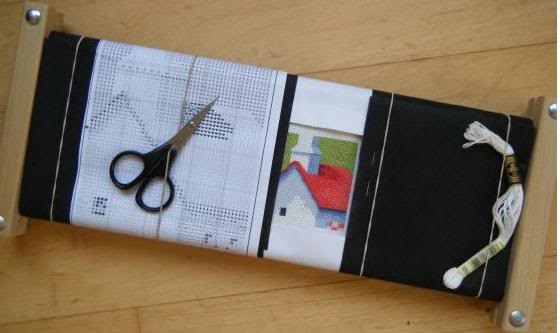
When I began to use a scroll frame for the first time I sewed together two rectangles of very stretchy fabric to make a "tube top" and a "tube skirt" to cover the areas that I wasn't currently stitching.

It worked very well but as I was stitching it occurred to me that I could also use sections of very stretchy hosiery to make seam free covers. For my first try I found a pair black and grey patterned Queen sized trouser sock. It worked very well but I when I parked my needle in the cover it was too well camouflaged. So I bought a pair of opaque pink little girl tights.
First I cut one whole leg and used it to cover one end. I pulled it onto the frame until I had covered about half the frame. The cut end naturally curled when it was stretched and I encouraged it to roll a little more. Then I folded it back to make a pocket.

I tucked the foot end in at the end of the frame.

I cut off the other leg of the stocking and pulled it onto the frame at the other end. I pulled it a little further than half and rolled the end back. I tucked in that foot as well. (Note that stockings securely hold the rectangles of acid free paper that I use to cover the exposed rolled edges.)

Then I used three elastics to attach the chart. (I have found that the elastics make the best line markers that I have ever used.) I can use the pocket at the front to hold a skein of floss...

... and the one at the back to hold my scissors. I can also slide a small ziplock of floss into the other stocking between stitching sessions. Between sessions I also have the option of unfolding the folded end to completely cover the fabric.

As sleek as the frames look with the stockings stretched over the ends it is easier to install and remove the covers when they are cut to length. By the time I was ready to stitch the next section I had figured out how long that I wanted the two sections of stocking. I cut them a bit longer than required so that I could roll the ends. To stitch the section that is closest to the edge of the frame I folded the stocking twice, so that there were three layers. The handy thing about this is that it gives me a pocket no matter which end of the frame I'm using at the top, ie. when I wish to turn it upside down I have a pocket that won't drop the scissors.

This frame measures less than 6 inches between the dowels so the little girl tights (size 38-50 lbs) were big enough to stretch over my frame. If I ever use larger frames women's tights might do the job, if I can find them in a colour that doesn't hide the needle. (I also noticed some men's microfiber knee high stockings that were very stretchy.) For even wider frames I could go back to sewing rectangles of stretchy fabric into tubes. Or I could knit some ribbed tubes from light weight yarn. I know that I could also use rectangles of interfacing held in place with elastic(s)...

...but I would miss the pockets!

Pinwheel 2010

This is such an amazingly cool idea as I worry about the sections I am not working on getting dirty. I LOVE it...thank you.
ReplyDeleteThis is such an amazingly cool idea as I worry about the sections I am not working on getting dirty. I LOVE it...thank you.
ReplyDelete